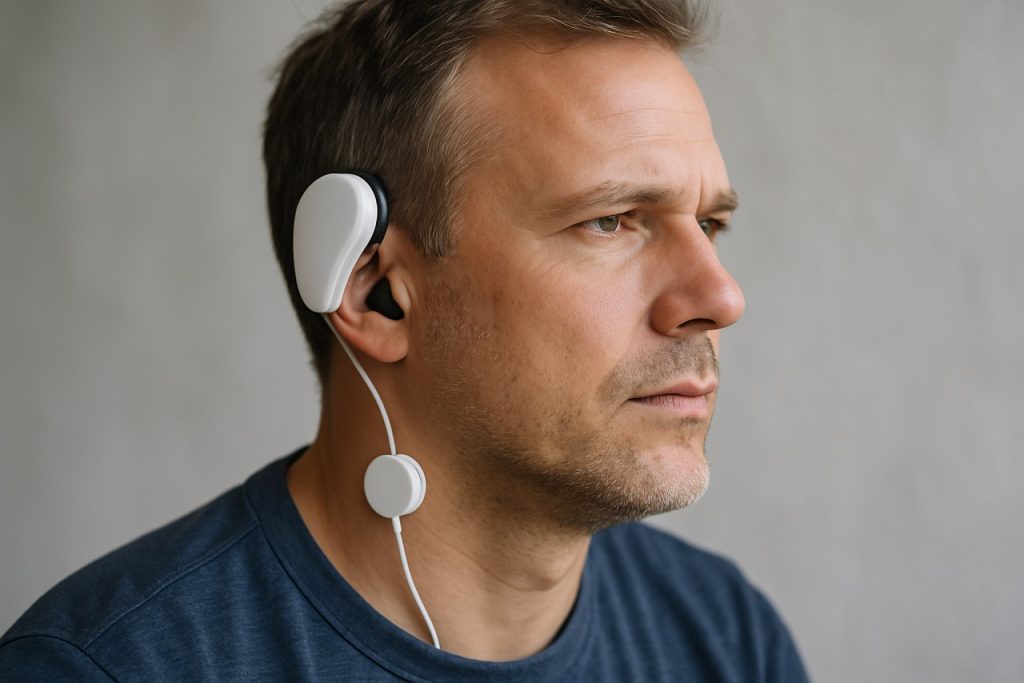
Auditory Neuromodulation Devices Market Report 2025: In-Depth Analysis of Growth Drivers, Technology Innovations, and Global Opportunities. Explore Market Size, Leading Players, and Strategic Forecasts Through 2030.
- Executive Summary & Market Overview
- Key Technology Trends in Auditory Neuromodulation Devices
- Competitive Landscape and Leading Companies
- Market Growth Forecasts (2025–2030): CAGR, Revenue, and Volume Analysis
- Regional Market Analysis: North America, Europe, Asia-Pacific, and Rest of World
- Future Outlook: Emerging Applications and Investment Hotspots
- Challenges, Risks, and Strategic Opportunities
- Sources & References
Executive Summary & Market Overview
Auditory neuromodulation devices represent a rapidly evolving segment within the broader neuromodulation and neurotechnology markets. These devices are designed to modulate neural activity in the auditory pathways, primarily targeting conditions such as tinnitus, sensorineural hearing loss, and certain neurological disorders. The global market for auditory neuromodulation devices is projected to experience robust growth through 2025, driven by increasing prevalence of auditory disorders, technological advancements, and expanding clinical evidence supporting efficacy.
According to recent analyses, the global tinnitus population alone is estimated at over 740 million, with a significant portion seeking effective therapeutic interventions beyond traditional pharmacological and behavioral therapies. This unmet need is fueling demand for innovative solutions such as auditory neuromodulation devices, which include both implantable and non-invasive systems. Key players in this market, such as Neuromod Devices, Neuromonics, and Lenire, are advancing device-based therapies that leverage sound stimulation, electrical stimulation, or a combination thereof to alter maladaptive neural activity associated with auditory dysfunction.
- Market Size & Growth: The global auditory neuromodulation devices market was valued at approximately USD 350 million in 2023 and is expected to grow at a CAGR of 8-10% through 2025, according to Grand View Research and MarketsandMarkets.
- Drivers: Key growth drivers include rising awareness of tinnitus and hearing loss, increasing geriatric population, and greater adoption of non-invasive neuromodulation therapies. Regulatory approvals and reimbursement expansions in North America and Europe are also accelerating market penetration.
- Challenges: Barriers include high device costs, limited long-term clinical data, and variability in patient response. However, ongoing R&D and real-world evidence generation are expected to address these challenges.
- Regional Trends: North America and Europe currently dominate the market, supported by strong healthcare infrastructure and early technology adoption. Asia-Pacific is emerging as a high-growth region due to rising healthcare investments and increasing prevalence of auditory disorders.
In summary, the auditory neuromodulation devices market in 2025 is characterized by dynamic innovation, expanding clinical adoption, and a favorable regulatory environment. The sector is poised for continued growth as new entrants and established players alike invest in next-generation solutions to address the significant global burden of auditory disorders.
Key Technology Trends in Auditory Neuromodulation Devices
Auditory neuromodulation devices are experiencing rapid technological evolution, driven by advances in neuroscience, miniaturization, and digital health integration. In 2025, several key technology trends are shaping the development and adoption of these devices, which are primarily used for conditions such as tinnitus, depression, and auditory processing disorders.
- Closed-Loop Systems: The integration of real-time feedback mechanisms is a significant trend. Closed-loop auditory neuromodulation devices can monitor neural responses and automatically adjust stimulation parameters, enhancing therapeutic efficacy and personalization. This approach is being explored in both invasive and non-invasive devices, with research supported by organizations such as the National Institutes of Health.
- Non-Invasive Stimulation Modalities: There is a marked shift toward non-invasive technologies, such as transcutaneous auricular vagus nerve stimulation (taVNS) and bimodal stimulation (combining auditory and somatosensory inputs). These methods reduce risk and improve patient compliance, as highlighted in recent clinical trials and reviews by the Frontiers Media journals.
- Wearable and Mobile Integration: The miniaturization of hardware and advances in battery technology have enabled the development of discreet, wearable neuromodulation devices. Integration with smartphones and mobile apps allows for remote monitoring, data collection, and patient engagement, as seen in products from companies like Neuromod Devices.
- Artificial Intelligence and Machine Learning: AI-driven algorithms are increasingly used to analyze patient data and optimize stimulation protocols. Machine learning models can predict patient response and tailor therapy, improving outcomes and reducing trial-and-error in treatment, as reported by Frost & Sullivan.
- Cloud-Based Data Management: Secure cloud platforms are being adopted for storing and analyzing large volumes of patient data, facilitating longitudinal studies and multi-center trials. This trend supports evidence-based refinement of neuromodulation therapies, as noted by MarketsandMarkets.
These technology trends are collectively enhancing the precision, accessibility, and effectiveness of auditory neuromodulation devices, positioning the sector for continued growth and innovation in 2025 and beyond.
Competitive Landscape and Leading Companies
The competitive landscape for auditory neuromodulation devices in 2025 is characterized by a mix of established medical device manufacturers, specialized neurotechnology firms, and emerging startups. The market is driven by increasing prevalence of tinnitus and other auditory disorders, as well as growing clinical evidence supporting neuromodulation as a viable treatment option. Key players are focusing on technological innovation, clinical validation, and strategic partnerships to strengthen their market positions.
Among the leading companies, Neuromod Devices stands out with its Lenire system, which has received CE marking and is undergoing further clinical trials in the U.S. and Europe. The company’s device uses bimodal neuromodulation, combining auditory and tongue stimulation, and has demonstrated significant efficacy in reducing tinnitus symptoms in large-scale studies. Neuromod Devices has also expanded its distribution network across Europe and is actively pursuing regulatory approvals in North America.
Another prominent player is Neuromodulation Technologies, which focuses on non-invasive transcranial and transcutaneous stimulation devices. Their portfolio includes products targeting both tinnitus and broader neurological disorders, leveraging proprietary algorithms for personalized therapy. The company has established collaborations with academic institutions to accelerate clinical research and product development.
In the U.S., Neuromodulation Technologies and Neuromod Devices face competition from startups such as Sensimetrics Corporation, which is developing wearable neuromodulation solutions with a focus on user comfort and remote monitoring capabilities. These companies are leveraging digital health platforms to enhance patient engagement and collect real-world data for ongoing product improvement.
The competitive environment is further shaped by strategic moves such as mergers, acquisitions, and licensing agreements. For example, Neuromod Devices has entered into partnerships with hearing aid manufacturers to integrate neuromodulation features into traditional hearing devices, broadening their addressable market. Additionally, intellectual property protection and regulatory compliance remain critical differentiators, with leading firms investing heavily in patent portfolios and clinical trial pipelines.
Overall, the auditory neuromodulation device market in 2025 is marked by rapid innovation, increasing clinical adoption, and intensifying competition among both established and emerging players, all vying to capture a share of the growing demand for effective tinnitus and auditory disorder therapies.
Market Growth Forecasts (2025–2030): CAGR, Revenue, and Volume Analysis
The global market for auditory neuromodulation devices is poised for robust growth between 2025 and 2030, driven by increasing prevalence of tinnitus and hearing disorders, technological advancements, and expanding clinical applications. According to projections by Grand View Research, the tinnitus management market—which includes auditory neuromodulation devices—is expected to register a compound annual growth rate (CAGR) of approximately 7.5% during this period. This growth is underpinned by rising awareness among patients and healthcare providers, as well as the growing adoption of non-invasive neuromodulation therapies.
Revenue analysis indicates that the global auditory neuromodulation devices market could surpass USD 1.2 billion by 2030, up from an estimated USD 780 million in 2025. This revenue expansion is attributed to the increasing number of product launches, favorable reimbursement scenarios in developed markets, and the entry of new players offering innovative device platforms. Notably, companies such as Neuromod Devices and Lenire are at the forefront, with their devices gaining regulatory approvals and expanding into new geographies.
In terms of volume, the annual unit sales of auditory neuromodulation devices are expected to grow at a CAGR of 8–9% from 2025 to 2030. This uptick is fueled by the increasing diagnosis rates of tinnitus and related auditory conditions, as well as the growing acceptance of neuromodulation as a first-line or adjunct therapy. The Asia-Pacific region, in particular, is projected to witness the fastest volume growth, owing to large patient populations and improving healthcare infrastructure, as highlighted by Fortune Business Insights.
- CAGR (2025–2030): 7.5% (revenue), 8–9% (volume)
- Projected Market Size (2030): USD 1.2 billion
- Key Growth Drivers: Technological innovation, rising prevalence of tinnitus, expanding clinical evidence, and favorable reimbursement policies
- Regional Highlights: North America and Europe remain dominant, but Asia-Pacific is the fastest-growing region
Overall, the auditory neuromodulation devices market is set for significant expansion through 2030, with both established and emerging players investing in R&D and market penetration strategies to capture the growing demand.
Regional Market Analysis: North America, Europe, Asia-Pacific, and Rest of World
The global market for auditory neuromodulation devices is experiencing differentiated growth across key regions—North America, Europe, Asia-Pacific, and the Rest of the World—driven by varying levels of technological adoption, regulatory environments, and prevalence of auditory disorders.
North America remains the largest market, underpinned by robust healthcare infrastructure, high awareness of tinnitus and related auditory conditions, and significant investments in R&D. The United States, in particular, benefits from a strong presence of leading device manufacturers and academic collaborations. The region’s favorable reimbursement policies and early adoption of innovative therapies have accelerated market penetration. According to Grand View Research, North America accounted for over 40% of the global market share in 2024, with continued growth expected as clinical evidence supporting neuromodulation efficacy expands.
Europe follows closely, with countries such as Germany, the UK, and France leading in both clinical research and device adoption. The European market is characterized by a supportive regulatory framework, exemplified by the CE marking process, which facilitates faster market entry for new devices. Public health initiatives targeting hearing loss and tinnitus, along with collaborations between universities and device manufacturers, are propelling growth. The MarketsandMarkets report highlights that Europe’s market is projected to grow at a CAGR of over 8% through 2025, driven by increasing prevalence of age-related hearing disorders and government support for innovative therapies.
- Asia-Pacific is emerging as a high-growth region, fueled by rising healthcare expenditure, expanding access to advanced medical technologies, and a large, aging population susceptible to auditory disorders. Countries like Japan, China, and South Korea are investing in healthcare modernization and are witnessing increased adoption of neuromodulation devices. However, market growth is somewhat tempered by limited reimbursement and lower awareness compared to Western markets. Nonetheless, Fortune Business Insights projects double-digit growth rates for the region through 2025.
- Rest of the World (including Latin America, Middle East, and Africa) represents a nascent but promising market. Growth is primarily driven by urbanization, improving healthcare infrastructure, and gradual increases in disposable income. However, challenges such as limited specialist availability and regulatory hurdles persist. Market expansion in these regions is expected to accelerate as awareness and access improve.
Overall, regional dynamics in the auditory neuromodulation devices market reflect a combination of demographic trends, healthcare policy, and technological readiness, with North America and Europe leading, and Asia-Pacific poised for rapid expansion through 2025.
Future Outlook: Emerging Applications and Investment Hotspots
The future outlook for auditory neuromodulation devices in 2025 is shaped by rapid technological advancements, expanding clinical applications, and a surge in investment activity. As the global burden of hearing disorders and neurological conditions such as tinnitus, depression, and epilepsy continues to rise, auditory neuromodulation is emerging as a promising therapeutic frontier. The convergence of neuroscience, bioelectronics, and digital health is driving innovation, with several emerging applications and investment hotspots poised to define the market landscape.
One of the most significant emerging applications is the use of auditory neuromodulation for the treatment of tinnitus. Clinical trials and real-world evidence suggest that devices delivering targeted sound stimulation or electrical impulses to the auditory pathway can provide meaningful symptom relief for patients with chronic tinnitus, a condition affecting over 10% of the global population. Companies such as Neuromod Devices and Lenire are at the forefront, with their non-invasive devices gaining regulatory traction and commercial momentum in Europe and North America.
Beyond tinnitus, auditory neuromodulation is being explored for cognitive enhancement, mood disorders, and even neurorehabilitation post-stroke. Research collaborations between academic institutions and industry players are accelerating the development of closed-loop systems that adapt stimulation parameters in real time, potentially improving efficacy and patient outcomes. The integration of artificial intelligence and machine learning into device platforms is expected to further personalize therapy and expand indications.
From an investment perspective, 2025 is likely to see increased venture capital and strategic funding in this sector. According to Grand View Research, the global neuromodulation devices market is projected to grow at a CAGR of over 9% through 2030, with auditory applications representing a key growth segment. Hotspots for investment include North America and Western Europe, where regulatory frameworks are supportive and reimbursement pathways are evolving. Additionally, Asia-Pacific is emerging as a high-potential region due to rising healthcare expenditure and growing awareness of neurological health.
In summary, the future of auditory neuromodulation devices in 2025 is characterized by expanding clinical applications, technological convergence, and robust investment activity. Stakeholders should monitor regulatory developments, clinical trial outcomes, and strategic partnerships as the market matures and new therapeutic frontiers are unlocked.
Challenges, Risks, and Strategic Opportunities
Auditory neuromodulation devices, which leverage electrical or acoustic stimulation to modulate neural activity for conditions such as tinnitus, hearing loss, and certain neurological disorders, face a complex landscape of challenges and risks in 2025. However, these hurdles also present strategic opportunities for innovation and market expansion.
One of the primary challenges is the regulatory pathway. Devices in this category often straddle the line between medical devices and neurotherapeutics, requiring rigorous clinical validation and compliance with evolving standards from agencies such as the U.S. Food and Drug Administration and the European Commission. The need for robust, long-term efficacy and safety data can delay product launches and increase development costs. Additionally, reimbursement remains a significant barrier, as payers demand clear evidence of cost-effectiveness and clinical benefit before approving coverage.
Technical risks are also prominent. Achieving precise, individualized neuromodulation without off-target effects is a persistent engineering challenge. Device miniaturization, battery life, and wireless connectivity are critical for patient adherence and usability, yet they add layers of complexity to product development. Furthermore, cybersecurity concerns are rising as more devices incorporate wireless and cloud-based features, necessitating stringent data protection protocols.
Market adoption is hindered by limited clinician awareness and training, as well as patient hesitancy regarding implantable or wearable neurotechnology. The competitive landscape is intensifying, with established players like Cochlear Limited and MED-EL expanding their portfolios, while startups introduce novel approaches such as bimodal stimulation and AI-driven personalization.
Despite these challenges, strategic opportunities abound. The growing prevalence of tinnitus and age-related hearing loss, coupled with increasing acceptance of neuromodulation therapies, is expanding the addressable market. Partnerships with academic institutions and digital health companies can accelerate R&D and enhance device functionality. Moreover, leveraging real-world evidence and digital biomarkers can strengthen value propositions for payers and regulators. Companies that invest in clinician education, patient engagement, and post-market surveillance are well-positioned to build trust and capture market share in this evolving sector.
Sources & References
- Neuromod Devices
- Neuromonics
- Lenire
- Grand View Research
- MarketsandMarkets
- National Institutes of Health
- Frontiers Media
- Frost & Sullivan
- Neuromodulation Technologies
- Fortune Business Insights
- European Commission
- Cochlear Limited
- MED-EL



